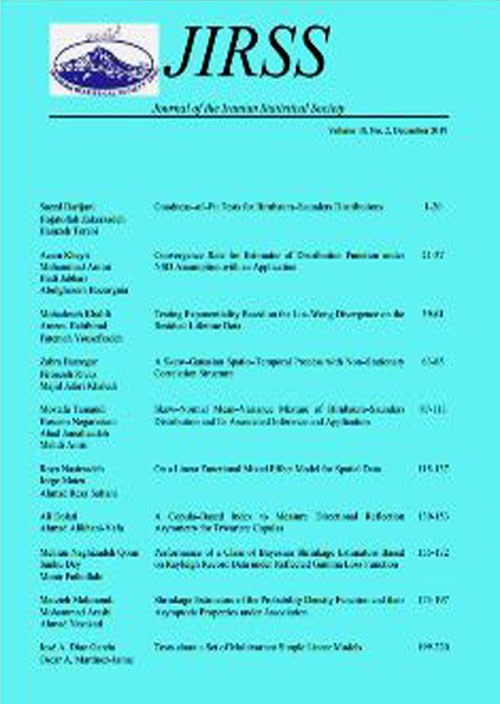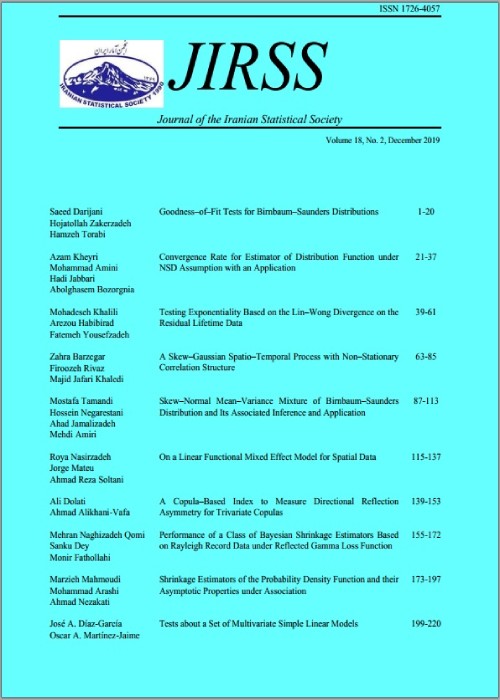فهرست مطالب

Journal of Iranian Statistical Society
Volume:19 Issue: 2, Autumn 2020
- تاریخ انتشار: 1400/02/26
- تعداد عناوین: 9
-
-
Convergence Rate of Empirical Autocovariance Operators in H-Valued Periodically Correlated ProcessesPages 1-13
This paper focuses on the empirical autocovariance operator of H-valued periodically correlated processes. It will be demonstrated that the empirical estimator converges to a limit with the same periodicity as the main process. Moreover, the rate of convergence of the empirical autocovariance operator in Hilbert-Schmidt norm is derived.
Keywords: Convergence Rate, Autocovariance Operator, H-Valued Periodically Correlated Processes, Strongly Second Order Processes -
Pages 15-31
In this paper we obtain a consistent estimator when there exist some measurement errors and multicollinearity in the instrumental variables in a two stage least square estimation of parameters. We investigate the asymptotic distribution of the proposed estimator and discuss its properties using some theoretical proofs and a simulation study. A real numerical application is also provided for more illustration.
Keywords: Endogeneity, Shrinkage Estimators, Measurement Error Models, Instrumental Variable, Two Stage Least Square -
Pages 33-66
When modeling time series data using autoregressive-moving average processes, it is a common practice to presume that the residuals are normally distributed. However, sometimes we encounter non-normal residuals and asymmetry of data marginal distribution. Despite widespread use of pure autoregressive processes for modeling non-normal time series, the autoregressive-moving average models have less been used. The main reason is the difficulty in estimating the autoregressive-moving average model parameters. The purpose of this study is to address this intricacy by approximating maximum likelihood estimators, which is particularly important from model selection perspective. Accordingly, the coefficients and residual distribution parameters of the first-order stationary autoregressive-moving average model with residuals that follow exponential and Weibull families, were estimated. Then based on the simulation study, the obtained theoretical results were investigated and it was shown that the modified maximum likelihood estimators were suitable estimators to estimate the first-order autoregressive-moving average model parameters in non-normal mode. In a numerical example positive skewness of obtained residuals from fitting the first-order autoregressive-moving average model was shown. Following that, the parameters of candidate residual distributions estimated by modified maxim-um likelihood estimators and one of the estimated models for modeling the data was selected.
Keywords: Autoregressive-Moving Average Model, Exponential Family, Modified Maximum Likelihood Estimator, Non-Normal Residuals, Weibull Family -
Pages 67-99
In this paper, we introduce the concept of quantile-based generalized cumulative residual entropy of order $(alpha,beta)$ for residual and past lifetimes and study their properties. Further we study the proposed information measure for series and parallel system when random variable are untruncated or truncated in nature and some characterization results are presented. At the end, we study generalized weighted dynamic cumulative residual entropy in terms of quantile function.
Keywords: Generalized entropy, Cumulative residual entropy, Order statistics, Quantile function, Weighted entropy -
Pages 101-117
In this paper, the reconcilability between the P-value and the posterior probability in testing a point null hypothesis against the one-sided hypothesis is considered. Two essential families, non regular and exponential family of distributions, are studied. It was shown in a non regular family of distributions; in some cases, it is possible to find a prior distribution function under which P-value and posterior probability are achieved. However, in the exponential family of distributions, this agreement is based on the complete monotonicity of a function of hazard rate.
Keywords: Completely Monotone, Exponential Family of Distributions, Non Regular Family of Distributions, P-values, Posterior Probability -
Pages 119-131
It is well-known that the skew-normal distribution can provide an alternative model to the normal distribution for analyzing asymmetric data. The aim of this paper is to propose two goodness-of-fit tests for assessing whether a sample comes from a multivariate skew-normal (MSN) distribution. We address the problem of multivariate skew-normality goodness-of-fit based on the empirical Laplace transform and empirical characteristic function, respectively, using the canonical form of the MSN distribution. Applications with Monte Carlo simulations and real-life data examples are reported to illustrate the usefulness of the new tests.
Keywords: Multivariate Skew-Normal Distribution, Canonical Form, Laplace Transform, Characteristic Function -
Pages 133-143
There are several methods to make inferences about the parameters of the sampling distribution when we encounter the missing values and the censored data. In this paper, through the order statistics and the projection theorem, a novel algorithm is proposed to impute the missing values in the multivariate case. Then, the performance of this method is investigated through the simulation studies. In an attempt to validate the proposed method and compare it with some other methods a real data is used.
Keywords: Order Statistic, Imputation, Projection Theorem, Censored Data, Linear Regression Model -
Pages 145-173
This paper focuses on different methods of estimation and forecasting in first-order integer-valued autoregressive processes with Poisson-Lindley (PLINAR(1)) marginal distribution. For this purpose, the parameters of the model are estimated using Whittle, maximum empirical likelihood and sieve bootstrap methods. Moreover, Bayesian and sieve bootstrap forecasting methods are proposed and predicted value for h-step ahead of the series is obtained. Some simulations and a real data analysis are applied to compare the presented estimations and the prediction methods.
Keywords: Autoregressive, Estimation, Integer-Valued Time Series, Poisson-Lindley Distribution, Prediction -
Pages 175-204
Different approaches to goodness of fit (GOF) testing are proposed. This survey intends to present the developments on Goodness of Fit based on entropy during the last 50 years, from the very first origins until the most recent advances for different data and models. Goodness of fit tests based on Shannon entropy was started by Vasicek in 1976 and were continued by many authors. In this paper, we describe different GOF tests constructed by authors from the beginning to now. First, the problem of GOF and different types of GOF are stated. Then, the method of GOF tests based on entropy for complete and censored data is explained and all works proposed by authors in this subject are mentioned.
Keywords: Goodness of Fit Tests, Entropy, Monte Carlo Comparisons


